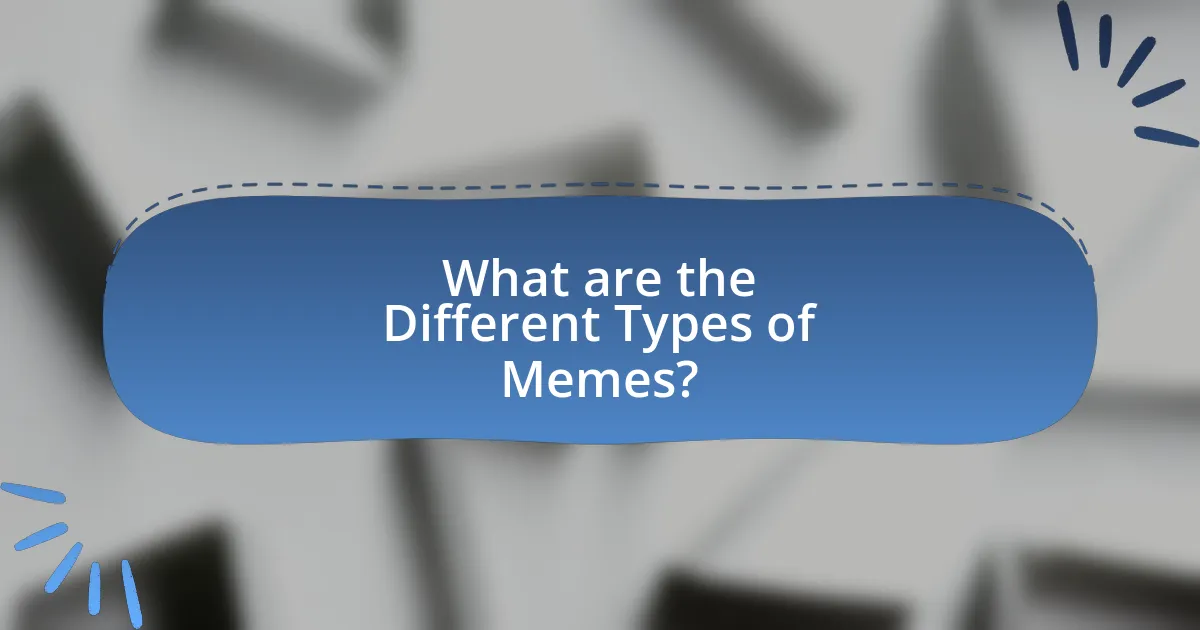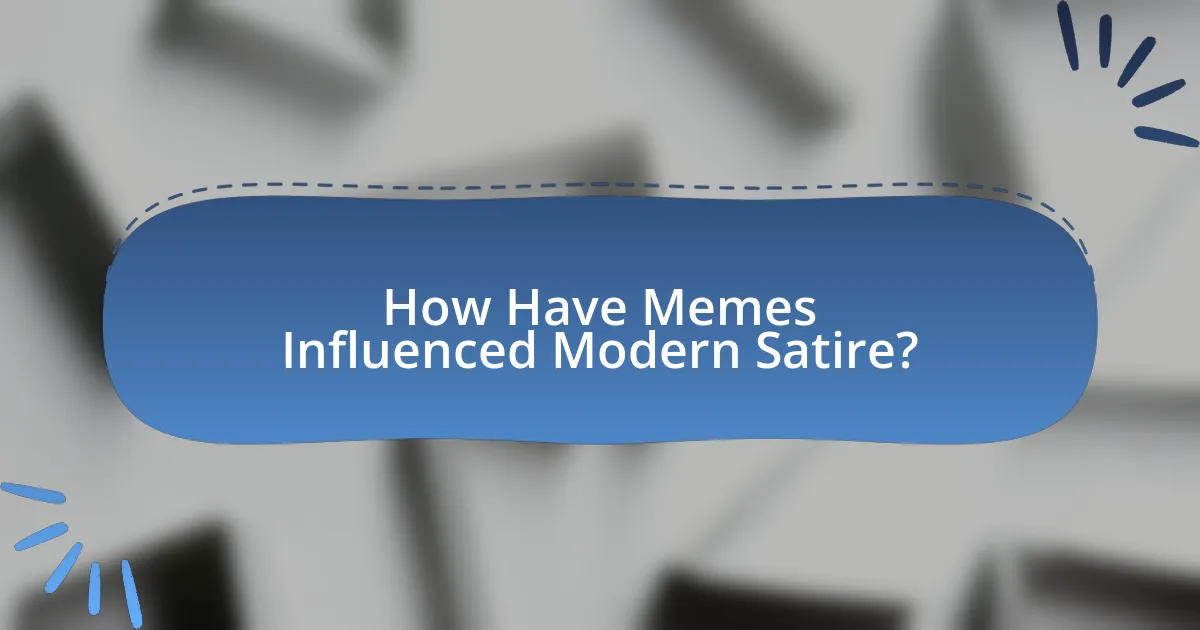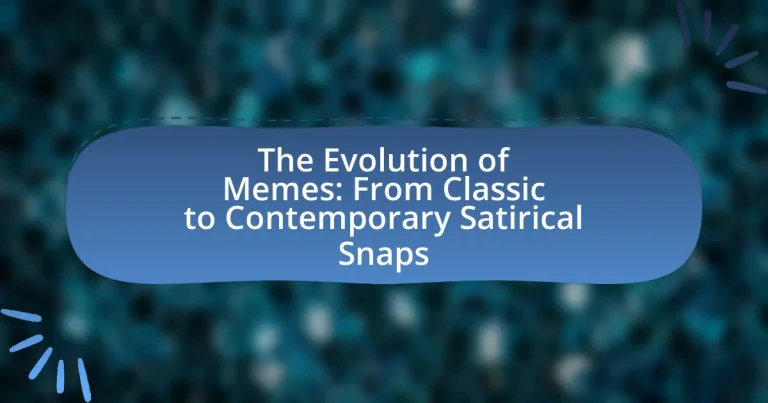Memes are defined as units of cultural information that spread virally, often conveying humor or social commentary. This article explores the historical context of memes, tracing their origins from Richard Dawkins’ concept in the 1970s to their evolution in the digital age, particularly through platforms like 4chan and Reddit. It examines the role of memes in communication and culture, their psychological effects on audiences, and their influence on modern satire and political commentary. Additionally, the article discusses the characteristics of classic versus contemporary memes, the key elements that contribute to their success, and best practices for creating effective memes.

What are Memes and Their Historical Context?
Memes are units of cultural information that spread virally, often in the form of images, videos, or text, and they typically convey humor or social commentary. The concept of memes was first introduced by evolutionary biologist Richard Dawkins in his 1976 book “The Selfish Gene,” where he described them as ideas that replicate and evolve similarly to genes. Historically, memes have evolved from simple cultural expressions, such as folk tales and jokes, to complex digital formats shared across social media platforms. The rise of the internet in the late 20th century significantly accelerated meme dissemination, with platforms like 4chan and Reddit serving as breeding grounds for contemporary memes, reflecting societal trends and collective humor.
How did memes originate and evolve over time?
Memes originated in the late 1970s with Richard Dawkins’ concept of “memes” in his book “The Selfish Gene,” where he described them as units of cultural transmission. Over time, the internet facilitated the rapid evolution of memes, particularly in the early 2000s with platforms like 4chan and Reddit, where image-based memes gained popularity. The introduction of social media further accelerated this evolution, allowing for the widespread sharing and remixing of memes, leading to diverse formats such as GIFs, videos, and viral challenges. This evolution reflects changes in technology and culture, with memes now serving as a form of social commentary and humor in contemporary digital communication.
What were the earliest forms of memes in digital culture?
The earliest forms of memes in digital culture were simple text-based jokes and images shared via email and early internet forums in the 1990s. Notably, the “Dancing Baby” animation, which emerged in 1996, is often cited as one of the first viral internet memes, showcasing how digital culture began to leverage humor and shared experiences. Additionally, the “All Your Base Are Belong to Us” phrase from a poorly translated video game became a significant meme in 2001, illustrating the rapid spread of digital content and the evolution of meme culture.
How did the internet influence the spread of memes?
The internet significantly accelerated the spread of memes by providing a global platform for rapid sharing and remixing. Social media platforms, forums, and websites like Reddit and Twitter enable users to create, share, and adapt memes instantly, reaching vast audiences within minutes. For instance, the viral nature of the “Distracted Boyfriend” meme exemplifies how quickly a single image can be transformed and disseminated across various cultures and contexts, illustrating the internet’s role in amplifying meme culture.
What role do memes play in communication and culture?
Memes serve as a significant tool for communication and cultural expression, acting as a medium through which ideas, humor, and social commentary are shared rapidly across digital platforms. They encapsulate complex concepts or emotions in a simple, relatable format, allowing for quick understanding and engagement among diverse audiences. For instance, a study by Shifman (2014) in “Memes in Digital Culture” highlights how memes can reflect societal values and norms, facilitating discussions on contemporary issues such as politics, identity, and social justice. This ability to convey messages succinctly and humorously contributes to their role in shaping cultural narratives and fostering community among users.
How do memes reflect societal values and trends?
Memes reflect societal values and trends by encapsulating the collective sentiments, humor, and cultural references of a specific time. They serve as a mirror to social norms, political climates, and popular culture, often highlighting issues such as inequality, identity, and current events. For example, during the COVID-19 pandemic, memes about social distancing and remote work became prevalent, illustrating the shared experiences and challenges faced by society. This phenomenon is supported by research from the Pew Research Center, which found that 55% of Americans engage with memes as a way to express their views on social issues. Thus, memes not only entertain but also provide insight into the evolving landscape of societal values and trends.
What psychological effects do memes have on audiences?
Memes have significant psychological effects on audiences, primarily influencing emotions, social behavior, and cognitive processing. They can evoke laughter, create a sense of belonging, and facilitate the sharing of cultural narratives. Research indicates that memes can enhance mood and foster social connections by providing relatable content that resonates with shared experiences. For instance, a study published in the journal “Computers in Human Behavior” by Shifman (2014) highlights how memes serve as a form of social commentary, allowing individuals to express opinions and engage in collective identity formation. Additionally, memes can reinforce stereotypes or challenge societal norms, impacting audience perceptions and attitudes.

What are the Different Types of Memes?
Different types of memes include image macros, GIFs, video memes, and text-based memes. Image macros typically feature a humorous image with overlaid text, often conveying a relatable sentiment or joke. GIFs are short, looping animations that can express emotions or reactions, frequently used in social media contexts. Video memes consist of short clips that are edited or captioned to create humor or commentary, often going viral on platforms like TikTok. Text-based memes rely solely on written content, such as jokes or quotes, and are commonly shared in forums or social media. Each type serves distinct purposes in communication and entertainment, reflecting cultural trends and social commentary.
How do classic memes differ from contemporary ones?
Classic memes differ from contemporary ones primarily in their format and cultural context. Classic memes often relied on simple images with text, such as the “Distracted Boyfriend” or “Bad Luck Brian,” which conveyed humor through straightforward visual and textual combinations. In contrast, contemporary memes utilize a broader range of multimedia elements, including videos, GIFs, and interactive content, reflecting the evolution of digital communication platforms like TikTok and Instagram.
Additionally, classic memes were typically rooted in specific internet subcultures and had a more universal appeal, while contemporary memes often reference current events, trends, and niche communities, making them more context-dependent. This shift is evidenced by the rapid virality of memes that respond to real-time events, such as political happenings or viral challenges, showcasing a more dynamic and immediate engagement with audiences.
What are some examples of classic memes and their characteristics?
Classic memes include “Bad Luck Brian,” “Success Kid,” and “Doge,” each characterized by distinct visual elements and cultural references. “Bad Luck Brian” features a photo of a teenage boy with braces and a plaid sweater, often captioned with unfortunate scenarios, highlighting irony and misfortune. “Success Kid” depicts a toddler with a determined expression, symbolizing triumph and achievement, often used to celebrate small victories. “Doge” showcases a Shiba Inu dog with multicolored text in Comic Sans font, expressing inner monologues in broken English, which emphasizes humor through absurdity and randomness. These memes have become iconic due to their relatability, humor, and ability to convey complex emotions succinctly.
What defines contemporary memes in today’s digital landscape?
Contemporary memes in today’s digital landscape are defined by their rapid dissemination, adaptability, and cultural relevance, often reflecting current events or social issues. These memes utilize various formats, including images, videos, and text, to convey humor or commentary, making them easily shareable across platforms like social media. The prevalence of user-generated content and the influence of algorithms on visibility further enhance their reach and impact, as evidenced by the viral nature of memes that can gain millions of views within hours.
What are the key elements that make a meme successful?
The key elements that make a meme successful include relatability, humor, and shareability. Relatability ensures that the audience can connect with the content, often drawing from shared experiences or cultural references. Humor engages viewers, making them more likely to share the meme with others, which enhances its virality. Shareability is crucial, as memes that are easy to share across social media platforms increase their reach and impact. Studies have shown that memes that evoke strong emotional responses, particularly laughter, are more likely to be shared, reinforcing the importance of these elements in meme success.
How does humor contribute to a meme’s effectiveness?
Humor significantly enhances a meme’s effectiveness by increasing its shareability and relatability. Memes that incorporate humor resonate more with audiences, making them more likely to be shared across social media platforms. Research indicates that humorous content is processed more quickly and remembered better, which contributes to its viral potential. For instance, a study published in the journal “Computers in Human Behavior” found that humorous memes received 50% more shares than non-humorous counterparts, demonstrating that humor plays a crucial role in engaging viewers and facilitating the spread of memes.
What role does relatability play in meme popularity?
Relatability significantly enhances meme popularity by allowing individuals to connect with the content on a personal level. When memes reflect shared experiences, emotions, or cultural references, they resonate more deeply with audiences, leading to increased sharing and engagement. Research indicates that memes that evoke relatable feelings, such as humor or nostalgia, are more likely to go viral; for instance, a study published in the journal “Computers in Human Behavior” found that memes with relatable themes received 60% more shares than those without. This connection fosters a sense of community among users, further amplifying the meme’s reach and impact.

How Have Memes Influenced Modern Satire?
Memes have significantly influenced modern satire by providing a rapid and accessible medium for social commentary. This influence is evident in how memes condense complex ideas into easily digestible formats, allowing for immediate engagement and sharing across social media platforms. For instance, the use of image macros and GIFs enables satirical content to reach wider audiences quickly, often reflecting current events or cultural phenomena in real-time. Research by Limor Shifman in “Memes in Digital Culture” highlights that memes serve as a form of participatory culture, where users actively contribute to and reshape satirical narratives. This democratization of satire has led to a more diverse range of voices and perspectives, making modern satire more inclusive and reflective of societal issues.
What is the relationship between memes and satire?
Memes and satire are closely related as both serve to critique and comment on societal norms, politics, and culture through humor. Memes often utilize visual elements and concise text to convey satirical messages, making complex ideas accessible and shareable. For instance, the use of popular culture references in memes can highlight absurdities in current events, similar to traditional satire found in literature and performance. This relationship is evident in the way memes have evolved to become a dominant form of social commentary in the digital age, reflecting the same principles of exaggeration and irony that characterize satire.
How do memes serve as a tool for political commentary?
Memes serve as a tool for political commentary by simplifying complex political issues into relatable and easily digestible formats. This visual and textual combination allows for rapid dissemination of ideas, often using humor or satire to critique political figures, policies, or societal norms. For instance, during the 2016 U.S. presidential election, memes played a significant role in shaping public perception, with platforms like Twitter and Facebook facilitating their spread. Research by the Pew Research Center indicates that 55% of U.S. adults reported encountering political memes online, highlighting their influence in modern political discourse.
What are the ethical considerations in meme-based satire?
Ethical considerations in meme-based satire include issues of consent, representation, and potential harm. Memes often utilize images or content without permission, raising questions about the rights of individuals depicted. Additionally, satire can perpetuate stereotypes or misinformation, impacting public perception and social discourse. For instance, a study by the Pew Research Center found that 64% of Americans believe that memes can mislead people about important issues, highlighting the responsibility of creators to consider the implications of their work. Furthermore, the potential for memes to incite hate or reinforce negative biases necessitates a careful approach to the subjects chosen for satire.
How do memes shape public opinion and discourse?
Memes shape public opinion and discourse by serving as tools for rapid communication and cultural commentary. They distill complex ideas into easily digestible formats, allowing individuals to express opinions, critique societal norms, and mobilize collective action. For instance, during political events, memes can influence voter perceptions and attitudes, as seen in the 2016 U.S. presidential election where memes played a significant role in shaping narratives around candidates. Research indicates that memes can reinforce existing beliefs and create echo chambers, as users share content that aligns with their views, thus impacting public discourse.
What impact do viral memes have on social movements?
Viral memes significantly amplify social movements by increasing visibility and engagement. They serve as powerful tools for communication, allowing complex ideas to be conveyed quickly and memorably, which can mobilize support and raise awareness. For instance, during the Black Lives Matter movement, memes like “I Can’t Breathe” became symbols of protest, spreading rapidly across social media platforms and fostering solidarity. Research indicates that memes can influence public opinion and political discourse, as seen in the 2016 U.S. presidential election, where memes played a crucial role in shaping narratives and voter perceptions. Thus, the impact of viral memes on social movements is profound, as they enhance outreach, foster community, and drive action.
How can memes perpetuate misinformation or stereotypes?
Memes can perpetuate misinformation or stereotypes by simplifying complex ideas into easily digestible images or phrases that often lack context. This simplification can lead to the spread of false narratives, as memes are frequently shared without verification. For instance, a study published in the journal “Computers in Human Behavior” found that memes can reinforce existing biases by presenting stereotypes in a humorous or relatable manner, making them more acceptable to audiences. Additionally, the viral nature of memes allows for rapid dissemination, which can amplify misleading information and stereotypes across social media platforms, further entrenching these misconceptions in public discourse.
What are some best practices for creating effective memes?
To create effective memes, focus on clarity, relatability, and humor. Clarity ensures that the message is easily understood, while relatability connects with the audience’s experiences or emotions, making the meme more shareable. Humor is crucial as it engages viewers and encourages them to share the content. Research indicates that memes that evoke laughter are more likely to be shared, as humor enhances social bonding and communication (Shifman, 2014, “Memes in Digital Culture”). Additionally, using high-quality images and concise text improves visual appeal and comprehension, further increasing the meme’s effectiveness.
How can one ensure a meme resonates with its intended audience?
To ensure a meme resonates with its intended audience, one must understand the audience’s interests, cultural references, and humor style. This understanding allows for the creation of content that aligns with the audience’s values and experiences. For example, memes that incorporate trending topics or relatable situations are more likely to engage viewers, as they tap into shared experiences. Research indicates that memes that reflect current events or popular culture achieve higher engagement rates, as seen in studies analyzing social media interactions. By tailoring content to the audience’s preferences and context, the likelihood of resonance increases significantly.
What tools and platforms are best for meme creation and sharing?
The best tools and platforms for meme creation and sharing include Canva, Adobe Spark, Imgflip, and social media platforms like Instagram and TikTok. Canva and Adobe Spark offer user-friendly interfaces with templates specifically designed for memes, allowing users to easily customize images and text. Imgflip provides a meme generator that allows users to create memes from popular templates and share them directly. Social media platforms like Instagram and TikTok facilitate the sharing of memes to a wide audience, leveraging their vast user bases to enhance visibility and engagement. These tools and platforms are widely recognized for their effectiveness in meme creation and sharing, evidenced by their popularity among users and content creators.


